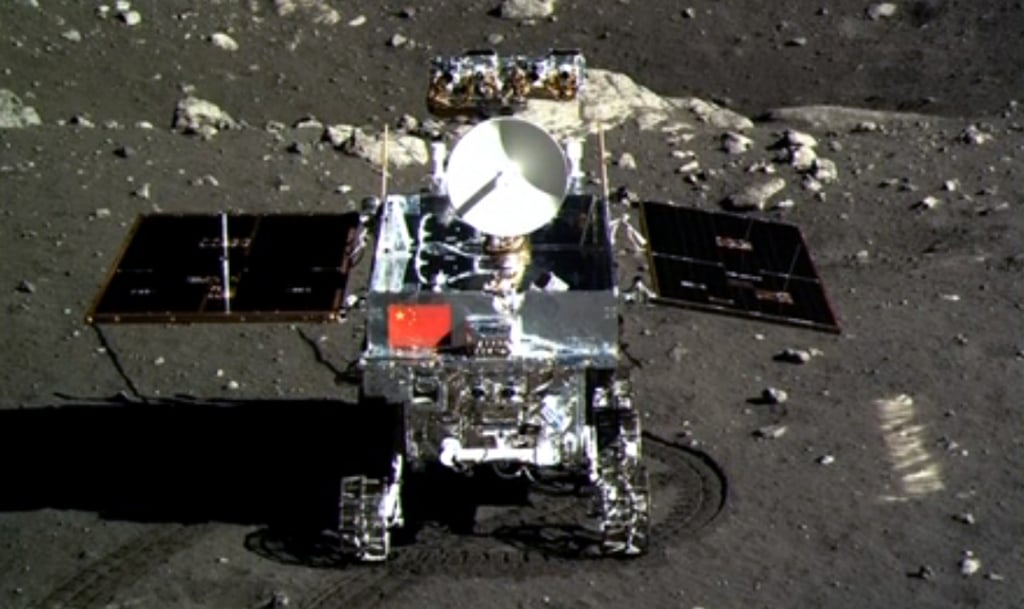
The Yutu, or Jade Rabbit, was deployed at 4:35 am local time, several hours after the Chang'e-3 probe landed on the moon, said the official news agency Xinhua.
The rover and lander began taking photos of each other late Sunday, including one that showed the bright red and yellow stars of the Chinese flag on the Jade Rabbit as it stands on the moon's surface.
Xinhua said the photographing began at about 11:42 pm after the rover moved to a spot a few metres away from the lander.
The colour images were transmitted live to the Beijing Aerospace Control Center, where Chinese President Xi Jinping and Premier Li Keqiang watched the broadcast.
China is the third country to complete a lunar rover mission after the United States and the former Soviet Union - a decade after it first sent an astronaut into space.
Beijing plans to establish a permanent space station by 2020 and eventually send a human to the moon.
The mission is seen as a symbol of China's rising global stature and technological advancement, as well as the Communist Party's success in reversing the fortunes of the once-impoverished nation.
Ma Xingrui, chief commander of China's lunar programme, declared the mission a "complete success" after the photographs showed the lander and rover were working, Xinhua said.
A message from the party's Central Committee, the State Council - China's cabinet - and the Central Military Commission branded the touchdown a "milestone" in China's space programme, as cited by Xinhua late Sunday.
"One Giant Leap for China," read the headline in Hong Kong's Sunday Morning Post, evoking the words in 1969 of American astronaut Neil Armstrong, the first man on the moon.
The landing, nearly two weeks after blast-off, was the first of its kind since the former Soviet Union's mission in 1976.
State broadcaster China Central Television (CCTV) featured extensive coverage of the mission and China's wider space ambitions.
The potential to extract the moon's resources has been touted as a key reason behind Beijing's space programme, with the moon believed to hold uranium, titanium, and other mineral resources, as well as offering the possibility of solar power generation.
"China wants to go to the moon for geostrategic reasons and domestic legitimacy," said China space expert Joan Johnson-Freese, a professor of national security affairs at the US Naval War College in Newport, Rhode Island.
"With the US exploration moribund at best, that opens a window for China to be perceived as the global technology leader - though the US still has more, and more advanced, assets in space."
News of the landing quickly made an impact on China's hugely popular Internet message boards, topping the list of searched items.
"The China dream has finally progressed one step forward!" wrote one user.
On its Sunday afternoon broadcast, CCTV aired video taken by the lander showing the rover leaving tracks in the dust as it gently coasted onto the moon's surface and rolled away.
The probe touched down on a 400-kilometre wide plain known in Latin as Sinus Iridum, or the Bay of Rainbows.
Before landing, the probe slowed down from 1,700 metres per second and then hovered for about 20 seconds, using sensors and 3D imaging to identify a flat area.
Thrusters were then deployed 100 metres from the lunar surface to gently guide the craft into position. The landing process started at 9:00 pm on Saturday and lasted for about 12 minutes.
Four minutes after landing, the Chang'e-3 unfolded solar panels that will provide energy to the lander and rover, the China Daily reported.
The landing had been considered the most difficult part of the mission.
The rover will spend about three months exploring the moon's surface and looking for natural resources.
It can climb slopes of up to 30 degrees and travel at 200 metres per hour, according to the Shanghai Aerospace Systems Engineering Research Institute.
The Chang'e-3 mission is named after the goddess of the moon in Chinese mythology, and the rover vehicle is called Yutu after her pet. Yutu's name was chosen in an online poll of 3.4 million voters.
Among those beyond China's borders offering their congratulations on the landing was former US vice president Al Gore, who wrote via Twitter: "Congratulations to China on reaching the moon with its rover - an impressive soft landing!"
COMMENTS (3)
Comments are moderated and generally will be posted if they are on-topic and not abusive.
For more information, please see our Comments FAQ

1729161093-0/liam-(4)1729161093-0-165x106.webp)


1732603002-0/lamar-(4)1732603002-0-165x106.webp)












Nicola Tesla demonstrated a safe and transmission of electricity via the medium of space over a sufficient distance a good 60 or 80 years ago. It was just a more concentrated electromagnetic wave .. but the idea was dumped and funding was taken off by a devil named J.P. Morgan just because it was supposed to challenge all the power giants and change global economic scape.. and nicola died in misery.
Read many years ago in a science journal that Moon has lot of Hydrogen 3 or Helium 3 which is very scarce on Earth (forgot what it was but most likely Helium 3) which scientists hope can be used for cold fusion nuclear technology to generate unlimited, cheap and safe electricity. Also, if electricity can be transmitted wirelessly and in a safe manner, it would solve all energy problems. This technology already exists in an infant stage and a California based company has demonstrated wireless transmission of electricity. If it comes to reality you can run cars and fly planes without carrying any fuel on board and its engines can run on electricity transmitted wirelessly from a power station or even moon or space. Who knows what other minerals Moon holds. I am not a scientist but scientists everywhere have their dreams of finding many resources on Moon. Humans may not live on Moon or Mars but robots can work there and supply resources and energy to humans on Earth.
CCTV means Close Circuit Television. If you mean CCTV (the chinese national television service) you should specify that. Otherwise it looks like the writer has no idea what they are talking about.